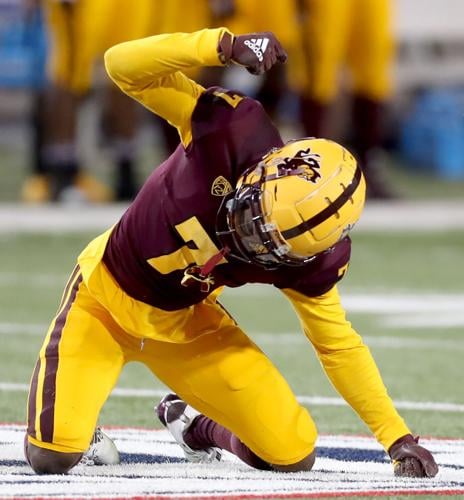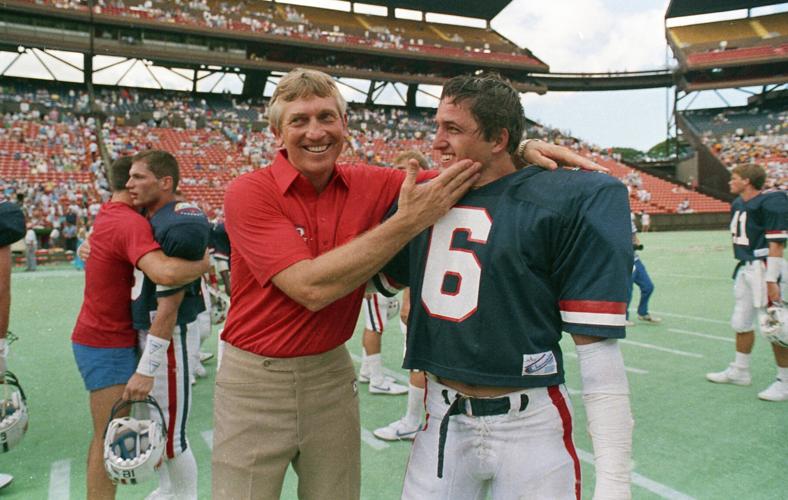Dear Mr. Football: Did ASU make any mistakes in its 70-7 Territorial Cup wipeout a year ago?
A: The Sun Devils unwittingly forced Arizona to fire Kevin Sumlin ASAP. They triggered an overnight decision to fire Sumlin, one that might’ve been delayed another year had they tapped the brakes in the first half, safely leading 28-0, played third-stringers and won, say, 35-10.
Instead, the Sun Devils built a 63-7 lead, so absorbed by the moment that on fourth-and-4 at the Arizona 25 with 7½ minutes remaining, they completed a pass to the 1-yard line and then scored to make it 70-7. Goodbye, Sumlin.
The UA administration, which eagerly hand-picked Sumlin three years earlier, could’ve cloaked another Territorial Cup loss in excuses — COVID-19, for one — to avoid a $7.5 million buyout. They could’ve used their standard line of “follow the process, the future is bright” and swallowed hard.
But not when it was 70-7. No Pac-12 team had scored 70 points against its geographical rival since 1929. As a result, Arizona got a year’s head start on infusing its football program with positivity, energy, competence, recruiting diligence and the will to fight back.
Dear Mr. Football: Does Arizona’s vow to avenge that historical loss really matter?
A: Sure it does. In 2005, No. 1 USC humiliated UCLA 66-19. A year later, a modestly average 6-5 UCLA team stunned Pete Carroll’s No. 2-ranked Trojans, 13-9, keeping them out of the national title game.
After Washington State was humbled in the 1991 Apple Cup by defending co-national champions Washington 55-10, the Cougars vowed to get even and a year later shocked the 9-1 Huskies 42-23.
However, this Arizona team doesn’t have anywhere near as much talent as the ’06 Bruins or ’92 Cougars, which were both bowl teams. I don’t think any Wildcats could crack ASU’s starting lineup except punter Kyle Ostendorp, although receiver Stanley Berryhill would surely be in ASU’s rotation.
It’s likely to take at least one more year, or longer, to avenge the 70-7 debacle. Oregon ran it up on Oregon State 69-10 in 2017 and it took the Beavers significant time to change coaching staffs and recruit better before getting the big payback win in 2020. That’s likely the Territorial Cup timeline, too.
Dear Mr. Football: What’s the origin of the Interstate 10 “No Pity for the Kitty” billboard?
A: Sun Devil boosters paid to erect the billboard after last year’s Territorial Cup. It’s not cheap. MoviaMedia.com estimates the monthly fee for 14-foot by 40-foot billboards in the greater Phoenix area to cost between $1,250 to $4,000 per month. A high-traffic area like I-10 near Casa Grande is probably closer to $4,000 per month. Is it worth $48,000 to pile on your rivals? Sure, if it’s not coming out of your pocket.
In some ways, the “No Pity for the Kitty” billboard is a tribute to three of the most prominent football players ever — Karl Eller, David Wood and Dana Wells. All made their fortunes in the outdoor billboard advertising business, much of it on I-10 between Tucson and Phoenix.
Eller, a Tucson High School all-state football player of the 1940s, was an Arizona standout from 1949-51. Wood, from Phoenix, was an All-Pac-10 defensive lineman on Arizona’s 1982 team that stunned 9-0-1 ASU and knocked them out of the Rose Bowl, starting an epic 8-0-1 streak against the Sun Devils.
Wells, the Pac-10’s 1988 defensive lineman of the year, played a big role in Arizona’s 1986 upset over Rose Bowl-bound ASU — the Chuck Cecil game. Wells is from Phoenix Brophy Prep.
Eller got Rincon High School and UA grad Arte Moreno, now the owner of the Los Angeles Angels, into the outdoor advertising business. Moreno later hired Wood and Wells. Wood is now president and CEO of Verde Outdoor Media, a Phoenix-based billboard company. Wells worked in the billboard business for 20 years before joining Moreno as VP of the Angels.
Not only that, UA defensive line coach Ricky Hunley, who made 12 tackles in the classic ’82 Territorial Cup upset over ASU, spent the last few years working in the Moreno-Wood-Wells linked outdoor advertising industry.
Dear Mr. Football: Why is ASU’s eternally short-of-expectations football (and basketball) program known by frustrated Sun Devil fans as Always Something University?
A: If ever ASU was going to break through and control the Pac-12 South, it would’ve been the last 10 seasons. Unimaginably, USC has finished in the AP Top 10 just once since 2012, when it was No. 3 in 2016. The Bruins equally underperformed, with just one recent Top-10 final ranking, in 2014.
The Pac-12 South has been wide open for a takeover for 10 years and the team you would’ve least predicted, Utah, has become the most feared football franchise. It not only goes back to bad head coaching, it goes back to ineffective athletic directors. USC and UCLA — as well as Arizona and ASU — set a woeful example for hiring bad football coaches the last 10 years.
Dear Mr. Football: Does ASU’s Herm Edwards fit in that “bad coach” category?
A: He’s not a bad coach. But he hasn’t been any more effective than predecessors Todd Graham, Dennis Erickson and Dirk Koetter. Edwards’ ballyhooed “pro model” system has splintered, and the Sun Devils are left to wonder what went wrong again.
It all goes back to the men Edwards hired. His initial staff, in 2018, went bust. Only two of his initial 10 assistant coaches remain on staff: defensive coordinator Antonio Pierce and special teams coach Shawn Slocum.
A lot of it is the ongoing NCAA investigation into recruiting irregularities that forced the Sun Devils to part ways with three coaches and elevate a consultant (Donnie Henderson), an analyst (Justin Wood) and an intern/GA (Trey Anderson) to full-time coaching spots.
Who survives that sort of chaos and crisis? More telling, only two of the eight coaches — New Mexico Lobos head coach Danny Gonzales and Michigan defensive line coach Shaun Nua — left for better jobs.
The others:
John Simon went to Memphis and is now out of coaching.
Rob Likens is a receivers coach at Miami; he had been the offensive coordinator at ASU.
Tony White is coaching at what looks to be a soon-to-be fired staff at Syracuse.
Charlie Fisher and Dave Christensen retired.
Donnie Yantis is coaching at a high school in Denver.
Just as hurtful, the two biggest names inside the ASU football program, ex-Sun Devil receiving star Derek Hagan (now coaching at Portland State) and big-name NFL lineman Kevin Mawae (back to the NFL) left the program.
Sounds a lot like the end of the Rich Rodriguez and Kevin Sumlin years at Arizona.
Dear Mr. Football: Does any of the “payback” chatter really matter for Arizona?
A: The motivation endures. After Arizona beat the Rose Bowl hopeful Sun Devils in a classic 28-18 game, 1982, Arizona coach Larry Smith talked emotionally about the genesis of that stunning upset, tracing it to 1973.
For nine years, Smith simmered about a 55-19 loss to Frank Kush’s Sun Devils in which he believed Kush piled on late in the game, scoring two late touchdowns as his team gained a historic 701 yards, then an NCAA Division I record.
Smith feared that loss would cost him his job and reputation as a young defensive coordinator. But after a successful head coaching stretch at Tulane, Smith returned to be Arizona’s head coach in 1980. He wanted a piece of ASU more than anything. Smith prominently displayed a four-part list of goals on the wall outside his McKale Center office. In order:
Have fun.
Beat ASU.
Earn a degree.
Win the Rose Bowl.
It took Smith two more humbling losses to ASU, in 1980 and 1981, before he triggered the 8-0-1 streak against the Sun Devils. UA coach Jedd Fisch is likely to have a similar wait before that billboard on I-10 fully goes away. Arizona won’t lose 70-7, but it probably won’t be close.
Sun Devils 42, Wildcats 13.





